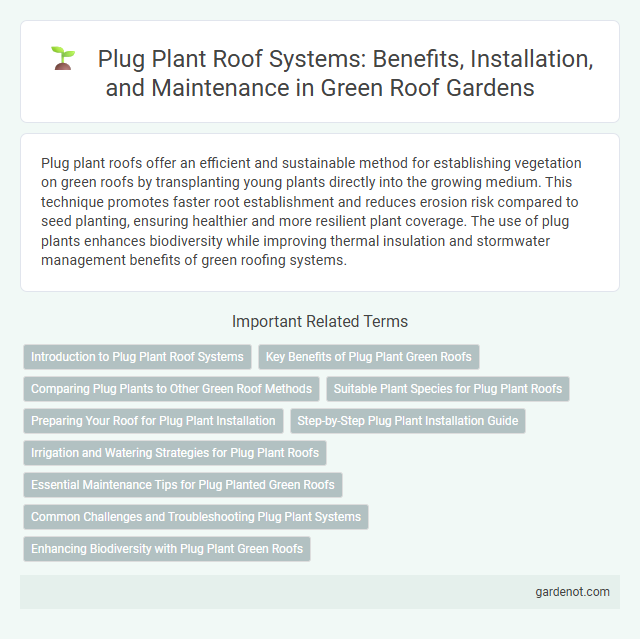Plug plant roofs offer an efficient and sustainable method for establishing vegetation on green roofs by transplanting young plants directly into the growing medium. This technique promotes faster root establishment and reduces erosion risk compared to seed planting, ensuring healthier and more resilient plant coverage. The use of plug plants enhances biodiversity while improving thermal insulation and stormwater management benefits of green roofing systems.
Introduction to Plug Plant Roof Systems
Plug plant roof systems utilize young, pre-grown plants inserted directly into growing medium on rooftops, promoting rapid establishment and green coverage. These systems support biodiversity by combining various plant species tailored to local climate and conditions, ensuring resilience and sustainability. The lightweight design and modular planting approach minimize structural load while enhancing stormwater management and thermal insulation.
Key Benefits of Plug Plant Green Roofs
Plug plant green roofs significantly enhance urban biodiversity by introducing diverse native plant species that improve habitat quality for pollinators and birds. These roofs offer superior stormwater management, reducing runoff volume and improving water quality through natural filtration. Energy efficiency is also boosted as plug plants provide excellent insulation, lowering heating and cooling costs in buildings.
Comparing Plug Plants to Other Green Roof Methods
Plug plant roofs offer faster establishment and greater plant survival rates compared to traditional seed-based green roofs due to pre-grown vegetation requiring less maintenance. Unlike extensive green roofs that rely on seeds or cuttings, plug plants provide immediate visual impact and improved erosion control. This method also reduces installation time and minimizes the risk of weed infiltration, enhancing overall roof performance and longevity.
Suitable Plant Species for Plug Plant Roofs
Suitable plant species for plug plant roofs include drought-tolerant sedums, succulents, and native wildflowers that thrive in shallow substrates and variable moisture conditions. Such species, like Sedum album, Sedum spurium, and Sempervivum, provide excellent ground cover and enhance biodiversity while requiring minimal maintenance. Selecting plants adapted to local climate and soil ensures plug plant roofs promote sustainable urban ecosystems and maximize green infrastructure benefits.
Preparing Your Roof for Plug Plant Installation
Preparing your roof for plug plant installation involves ensuring the substrate is clean, level, and properly waterproofed to support healthy plant growth. Installing a high-quality drainage layer and root barrier protects the roofing structure while facilitating optimal water retention and aeration for the plug plants. Thorough preparation guarantees the long-term success and sustainability of the green roof system.
Step-by-Step Plug Plant Installation Guide
Begin plug plant installation on a green roof by preparing the growing medium, ensuring it is level and adequately moist to support root establishment. Space each plug plant according to the species' mature size, typically 6 to 12 inches apart, to optimize growth and coverage. Water the newly planted plugs thoroughly and maintain consistent irrigation to encourage rapid root development and plant establishment.
Irrigation and Watering Strategies for Plug Plant Roofs
Effective irrigation and watering strategies for plug plant roofs involve using drip irrigation systems to deliver precise amounts of water directly to the root zones, minimizing water waste. Incorporating moisture sensors helps monitor soil moisture levels in real time, enabling automated watering schedules tailored to plant needs. Employing drought-tolerant plug plant species reduces overall water demand, enhancing sustainability in green roof design.
Essential Maintenance Tips for Plug Planted Green Roofs
Essential maintenance tips for plug planted green roofs include regular watering during the establishment phase to promote root growth and prevent drought stress. Inspecting plugs for signs of pests or disease ensures early intervention and healthy vegetation development. Periodic weeding and fertilization tailored to the specific plant species help maintain vibrant coverage and overall roof ecosystem balance.
Common Challenges and Troubleshooting Plug Plant Systems
Plug plant roofs often face challenges such as uneven plant establishment, water stress due to inadequate irrigation, and soil compaction affecting root growth. Common troubleshooting methods include adjusting irrigation schedules, improving substrate aeration, and selecting drought-tolerant plant varieties to enhance survival rates. Regular monitoring and maintenance are essential to address pest infestations and nutrient deficiencies that compromise plug plant health on green roofs.
Enhancing Biodiversity with Plug Plant Green Roofs
Plug plant green roofs significantly enhance urban biodiversity by providing diverse habitats for pollinators, birds, and beneficial insects. These roofs support a variety of native plant species, promoting ecological resilience and improving air quality. Incorporating plug plants accelerates vegetation establishment, creating vibrant ecosystems that sustain local wildlife populations.
Plug plant roof Infographic

 gardenot.com
gardenot.com